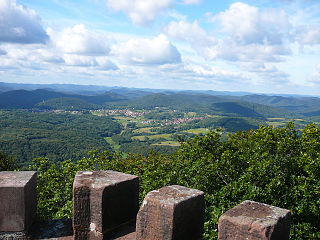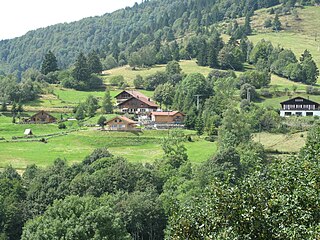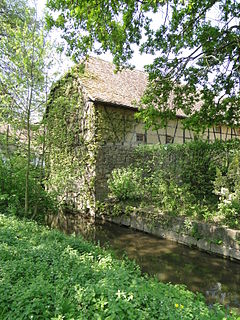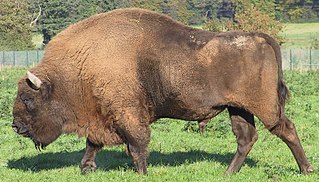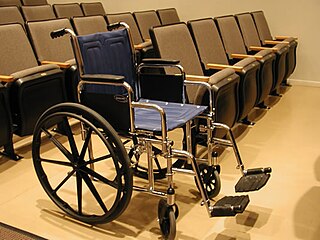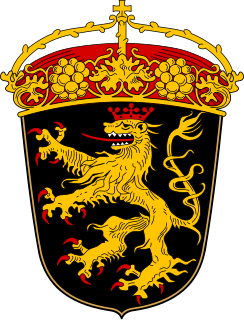
The Palatinate, historically also Rhenish Palatinate, is a region in southwestern Germany. It occupies roughly the southernmost quarter of the German federal state of Rhineland-Palatinate (Rheinland-Pfalz), covering an area of 5,451 square kilometres (2,105 sq mi) with about 1.4 million inhabitants. Its residents are known as Palatines.

Südliche Weinstraße is a district (Kreis) in the south of Rhineland-Palatinate, Germany. Neighboring districts are Südwestpfalz, Bad Dürkheim, the district-free city Neustadt (Weinstraße), Rhein-Pfalz-Kreis, Germersheim, and the French département Bas-Rhin. The district-free city Landau is surrounded by the district.

Neustadt an der Weinstraße is a town in Rhineland-Palatinate, Germany. With 54,000 inhabitants as of 2002, it is the largest town called Neustadt.

Forst an der Weinstraße is an Ortsgemeinde – a municipality belonging to a Verbandsgemeinde, a kind of collective municipality – in the Bad Dürkheim district in Rhineland-Palatinate, Germany.

The Palatinate Forest, sometimes also called the Palatine Forest, is a low-mountain region in southwestern Germany, located in the Palatinate in the state of Rhineland-Palatinate. The forest is a designated nature park covering 1,771 km2 and its highest elevation is the Kalmit.

Palatinate is a German wine-growing region (Weinbaugebiet) in the area of Bad Dürkheim, Neustadt an der Weinstraße, and Landau in Rhineland-Palatinate. Before 1993, it was known as Rhine Palatinate (Rheinpfalz). With 23,461 hectares under cultivation in 2008, the region is the second largest wine region in Germany after Rheinhessen. There are about 6,800 vintners producing around 6.5 million hectolitres of wine annually.

Birkenhördt is a municipality in the Südliche Weinstraße district, in Rhineland-Palatinate, Germany, and is an officially recognized tourist resort.

Gossersweiler-Stein is a municipality in Südliche Weinstraße district, in Rhineland-Palatinate, western Germany.

Rhodt unter Rietburg is a municipality in Südliche Weinstraße district, in Rhineland-Palatinate, western Germany. Rietburg castle (ruins) is located on a nearby hill. The village has been making wine for over 1200 years, and is one of the centres of Palatine wine as a home of Rietburg wine co-operative.
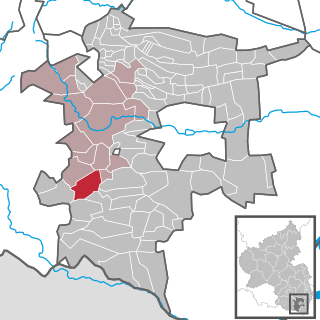
Silz is a municipality in Südliche Weinstraße district, in Rhineland-Palatinate, western Germany.

The Kalmit is the highest peak in the Palatinate Forest and the second highest in the Palatinate region of Germany. It is 672.6 m above sea level (NHN) and located 5.5 kilometres (3.4 mi) south of the town of Neustadt an der Weinstraße.
Hirschfeld Wildlife Park is in Hirschfeld, part of the municipality of Voigtsgrün, near Zwickau in the German Free State of Saxony.

The Rehberg is a prominent hill, 576.8 m above sea level (NHN), in the German state of Rhineland-Palatinate. After the Grand Wintersberg in French North Alsace, the Rehberg is the second highest hill in the Wasgau, the Franco-German region that forms the southern part of the Palatine Forest and runs from the valley of the River Queich to the Col de Saverne. The Rehberg is also the highest hill on German soil in the Wasgau. As part of the Palatine Forest-North Vosges Biosphere Reserve it has been placed under special protection measures.

Walking routes in the Palatine Forest fall into two categories. The first are longer walking routes, most of which are maintained by the Palatine Forest Club, or PWV, and which are linked to the national and international network of long distance paths. The second category are those local circular walks and themed walking routes, some of which are of wider regional importance, and which are maintained by municipal authorities. The Palatine Forest, as part of the Palatine Forest-North Vosges Biosphere Reserve, is an important conservation area. As a result, the Palatine Forest, the bunter sandstone landscape of the Palatine Forest Nature Park, the castles in the Dahner Felsenland and the cross-border paths into Alsace and the Vosges make the region particularly popular with ramblers and walkers.
The Erlenbach is a stream, over 9 km long, in the South Palatine Wasgau region of the German state of Rhineland-Palatinate. It is a left tributary of the Lauter which, here in its upper reaches is still called the Wieslauter.

The Orensberg, also known in the region as the Orensfels(en) due to the striking rock formations on its summit plateau, is a hill, 581.2 m above sea level (NHN), near Frankweiler in the county of Südliche Weinstraße in the German state of Rhineland-Palatinate. The hill is part of the Haardt mountain range that forms the eastern edge of the Palatinate Forest.

The Hüttenberg near Maikammer in the Rhineland-Palatinate county of Südliche Weinstraße is a subpeak, 620.1 m above sea level (NN), of the Kalmit the highest mountain in the Haardt in the eastern Palatinate Forest of Germany. There is a blockfield, the Hüttenberg Felsenmeer, along the crest.

The Upper Moselle is the name given in Germany to that section of the River Moselle, 45 kilometres long, that runs from the Franco-German-Luxembourg tripoint near Perl to its confluence with the Saar near Konz shortly before Trier. From the tripoint to its confluence with the Sauer, the Upper Moselle forms the border between the German states of the Saarland and Rhineland-Palatinate on the one side and Luxembourg on the other. This stretch of the river known as the Upper Moselle is, however, not the same as the geographical upper reaches of the Moselle, which run from its source near Bussang in the Vosges mountains in Lorraine via Épinal and Nancy roughly as far as Metz.
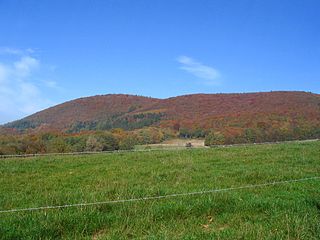
The Königsberg is a 568-metre-high hill in the collective municipality of Lauterecken-Wolfstein in the county of Kusel in the German state of Rhineland-Palatinate.

